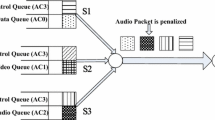Abstract
Wireless networks are used extensively in communication technologies. From Tesla to date researchers, many are working on wireless data transmission techniques and technologies. Despite the immense progressions over the past decade, there are precise hurdles that the industry endures to face. Bandwidth restrictions, latency problems, and device compatibility issues prevent the viewer from meeting seamless data transmissions. Many devices used for communication are used with the wireless interface and are proficient in transmitting data efficiently to the communication range. The growth in data communication requirements increases the network traffic and results in a network bottleneck. There are more challenges for Mobile Ad hoc Networks (MANETs) due to the additional overhead of resource constraints. Congestion leads to depletion of the node's energy, deterioration of network performance, and increased network latency and packet loss. As a result, energy-efficient and reliable state-of-the-art congestion control protocols must be designed to detect, notify and control congestion effectively. To minimize the packet loss in MANETs using Transmission Control Protocol (TCP), we proposed a data loss minimization technique (DLMT). Results show that enhanced DLMT outperforms by 18% compared to state-of-the-art proven congestion control mechanisms. DLMT improves the Quality of Service (QoS) constraints and improves performance by reducing the delay in better throughput, which can be seen by analyzing experimental results. The proposed coordination process's scalability and robustness are shown in good agreement with simulation results and analytic results for the stochastic model.











Similar content being viewed by others
References
Vivekananda, G. N., & Reddy, P. C. (2018). Performance evaluation of TCP, UDP, and SCTP in MANETS. ARPN Journal of Engineering and Applied Sciences, 13(9), 3087–3092
Vivekananda GN, Reddy PC (2017) Critical Analysis of Congestion Control for the Future Networks In Emerging Trends in Electrical. Communications, and Information Technologies. Springer, Singapore
Ren, F., He, T., Das, S. K., & Lin, C. (2011). Traffic-aware dynamic routing to alleviate congestion in wireless sensor networks. IEEE Transactions on Parallel and Distributed Systems, 22(9), 1585–1599
Basu A, Lin A, Ramanathan S (2003) Routing using potentials: a dynamic traffic-aware routing algorithm. In Proceedings of the 2003 conference on Applications, technologies, architectures, and protocols for computer communications, ACM, 37–48
Tang, D., Li, T., & Ren, J. (2017). Congestion-aware routing scheme based on traffic information in sensor networks. Ad Hoc and Sensor Wireless Networks, 35(3–4), 281–300
Sovaldi SR, Moghaddam MH (2014) Fuzzy TADR: A fuzzy extension to TADR algorithm for congestion control in wireless sensor network. In2014 Iranian Conference on Intelligent Systems (ICIS), IEEE, 1–5.
Lin, Q. M., Wang, R. C., Jian, G. U., & Sun, L. J. (2011). Novel congestion control approach in wireless multimedia sensor networks. The Journal of China Universities of Posts and Telecommunications, 18(2), 1–8
Sangwan, Y. S. (2015). To alleviate congestion in TADR by using combined dominating set technique. Wireless Sensor Networks, 7(2), 5–11
Ahuja, R. K., Magnanti, T. L., Orlin, J. B., & Weihe, K. (1995). Network flows: Theory, algorithms and applications. ZOR-Methods and Models of Operations Research, 41(3), 252–254
Anderson, E. J., Anderson, T. E., Gribble, S. D., Karlin, A. R., & Savage, S. (2002). A quantitative evaluation of traffic-aware routing strategies. ACM SIGCOMM Computer Communication Review, 32(1), 67–67
Stevens WR, Wright, GR (1995) TCP/IP illustrated: the implementation. Addison-Wesley Longman Publishing Co., Inc
Shah, S. A., Nazir, B., & Khan, I. A. (2017). Congestion control algorithms in wireless sensor networks: Trends and opportunities. Journal of King Saud University-Computer and Information Sciences, 29(3), 236–245
Tan D, Kim DS (2014) Dynamic traffic-aware routing algorithm for multi-sink wireless sensor networks. Wireless Networks (10220038), 20(6)
Tychogiorgos G, Gkelias A, Leung KK (2012) Utility-proportional fairness in wireless networks. In: 2012 IEEE 23rd International Symposium on Personal, Indoor and Mobile Radio Communications-(PIMRC), 839–844.
Vivekananda, G. N., & Ilknur, A. (2020). A congestion avoidance mechanism in multimedia transmission over MANET using SCTP multi-streaming. Multimedia Tools and Applications, 79(23), 16823–16844
Vivekananda, G. N., & Reddy, P. C. (2019). Packet loss minimising approach based on traffic prediction for multi-streaming communication over MANET. International Journal of Wireless and Mobile Computing, 17(1), 1–11
Bajaj, L., Takai, M., Ahuja, R., Tang, K., Bagrodia, R., & Gerla, M. (1999). Glomosim: A scalable network simulation environment. UCLA computer science department technical report, 990027(1999), 213
Kastrinogiannis T, Tsiropoulou EE & Papavassiliou S (2008) Utility-based uplink power control in CDMA wireless networks with real-time services. In: International Conference on Ad-Hoc Networks and Wireless, Springer, Berlin, Heidelberg, 307–320.
Huang, X. L., Ma, X., & Hu, F. (2018). Machine learning and intelligent communications. Mobile Networks and Applications, 23(1), 68–70
Author information
Authors and Affiliations
Corresponding author
Additional information
Publisher's Note
Springer Nature remains neutral with regard to jurisdictional claims in published maps and institutional affiliations.
Rights and permissions
About this article
Cite this article
Vivekananda, G.N., Lavanya, B.M. & Reddy, P.D.K. DLM technique for QoS improvement in MANETS. Wireless Netw 27, 2867–2877 (2021). https://doi.org/10.1007/s11276-021-02622-1
Accepted:
Published:
Issue Date:
DOI: https://doi.org/10.1007/s11276-021-02622-1




